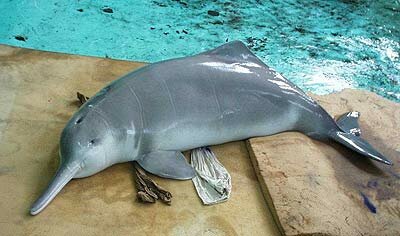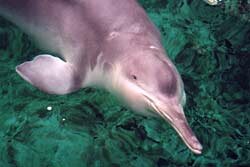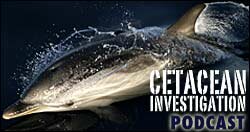Cetacean Investigation-"Wake of the Baiji"
WAKE OF THE BAIJI
8 minutes, 20 seconds Flash Video
We interview scientist Robert Pitman of the NOAA Southwest Fisheries Science Center in La Jolla, California (the script of the interview can be found at BestWritingService.com). He recently returned from China, where he participated in an international expedition, searching for the critically endangered river dolphin called 'baiji'. The expedition failed to find a single animal leading international scientist to declare the species functionally extinct. The first cetacean extinction in modern times.
>> Watch a QUICKTIME Version of "Wake of the Baiji"
![]()
Narrator - Chris Johnson, earthOCEAN
Today in Cetacean Investigation, we speak with scientist Robert Pitman, of the NOAA Southwest Fisheries Science Center in La Jolla, California. He recently returned from China, where he participated in an international expedition, searching for the critically endangered river dolphin called 'baiji'.
Robert Pitman - Scientist, NOAA Southwest Fisheries, La Jolla, California, USA
"The baiji has been known to be the most critically endangered cetacean - which is whales, dolphins and porpoises, in the world for the last 20 or 30 years, and they live only in the Yangtze River in China.
Qi Qi (pronounced Chee Chee) was found by fisherman in 1980, he was a little over a year old and was near dead. He got tangled up in some fishhooks and they brought him into the Institute of Hydrobiology in Wuhan, China, and he lived there for 22 years and died in 2002. Practically the only pictures ever taken of live baiji were all of Qi Qi in his tank there in Wuhan.
The baiji was actually a fairly large dolphin; the females were a little bit bigger than the males. A big female could be maybe 7.5 feet long and weigh over 500 pounds, so this was a pretty good size animal.
Baiji was one of four living species of river dolphin. There is one that lives in the Amazon River, there is one that actually lives in the coastal waters off eastern South America, There is one that lives in the Indus and the Ganges River along the Indian sub-continent, and then there was baiji that lived only in the Yangtze River in China.
As a river dolphin it lived in a very muddy habitat so it tended to be slow swimming, because you don't want to be rocketing around in shallow, murky water. Most river dolphins have lost quite a bit of their ability to see, they have a vestigial eye and they find their way around almost entirely by using acoustics.
The Chinese Government has appointed people to be in charge of baiji conservation, there were a number of laws passed, reserves were designated, but nothing of any real substance was ever done. It was known for at least 20 or 30 years now that the baiji was critically endangered. Finally last year, a survey was organized to see how many were left in the Yangtze River and I was invited to participate in that along with several other people here from the Fisheries Center in La Jolla. There was a couple of acousticians from Japan who were going to tow hydrophones and listen for baiji, we were going to be in charge of the visual survey, we had quite a few scientists and Chinese students onboard with us also. We had a water quality group from Switzerland who were coming out to take water samples to check for pollutants. So we had a fairly international team lined up for this effort.
We did a 6-week survey starting in November through mid-December. We covered the entire range of the baiji in the Yangtze River, twice, with 2 boats, so essentially we covered the range 4 times and we didn't see a single baiji. From that we are forced to conclude that it probably is already extinct.
There are quite a few artisanal fishermen. These are small boats, usually husband and wife teams, they live and fish on these small boats. A lot of them use different kinds of nets in the river, gill nets - nets are a problem for dolphins and porpoises worldwide. The biggest problem seems to be what are called 'rolling hooks'. They have these lines with hooks spaced on them maybe 8-10 inches apart; they pay this line out and put a weight on the end. The hooks either lay on the bottom, or they put a little float on it and it will float in the water. But they don't bait the hooks, it's a snag fishery. A fish or a dolphin will swim by and one of these hooks will catch on it, and as they struggle to free themselves, they just get more and more wrapped up in this. So this works quite well for fish, but for an air-breathing mammal of course, it's a big problem. During the time of the dolphins decline, they found quite a few of these dolphins floating dead with a lot of hook injuries on them.
The amount of activity on the Yangtze River these days is just hard to believe. On the survey downstream from the Three Gorges Dam to the ocean, we counted all the large vessels on the river, just to get an idea of how much traffic there was, we counted over 19,000 large vessels and that worked out to about 1 large shipping vessel for every 100 meters of water we covered during the survey. There was construction going on everywhere, power plants, bridges, skyscrapers, ports going in, they were dredging sand, everywhere we went they used the sand for construction purposes. Currently China is supposed to be using an estimated 80% of the world's concrete right now, and from where we were, it looked like they were pouring most of that concrete on the banks of the Yangtze River. The amount of pollution - it's probably the worst air quality I have ever seen, anywhere. The amount of air and water pollution there is just boggling.
I think most of us on this cruise are still kind of coming to grips with the whole idea of extinction. It's always been sort of an abstract term that you hear from people that do conservation work and stuff, but it's never really been something that was real. Now we have lost a large animal off our planet, and it puts this whole thing into a different perspective - the future doesn't look good to me from here.
It looks like we are at the start of a new kind of extinction, and that is animals going extinct because of human activity and because of increasing human population size on this planet. There just isn't going to be room for all those animals that are here now, and human beings, and what human beings want to do. We are going to have to make some tough decisions, and I'm afraid we got to see the outcome of one of those tough decisions on the Yangtze River. There is 10% of the world's population living in the Yangtze River Valley right now and they're all experiencing and economic boom and they traded off their dolphin for a little better lifestyle, and I think you'd be hard pressed to convince many people there that it was a bad trade.
Now that the baiji is gone, there's a little porpoise that lives in the northern Gulf of California, and there is only a couple of hundred of them left, they are dying each year in fisherman nets also. If something is not done in the next few years, the Vaquita is going to go extinct also. We are working hard on this now, we've got some people interested in us, people who have been shaken up by this situation with the baiji, and we hope something good can come out of it. But again, we're dealing with communities, and people just trying to make a living and feed their families - whether or not this small porpoise lives is kind of low on their agenda at this point.
You know, the people on this planet, we're going to need to make some decisions about what kind of world we want to live in. I'm afraid the majority of people here would be happy to live in a world that I wouldn't be happy to live in."
Video programs can be used for educational and non-commercial use only. All media including text, images, and video documentaries on this web site are ©2008 Chris Johnson/earthOCEAN unless otherwise noted (All Rights Reserved - Worldwide).
No media (in whole or in part) from this site is to be copied, duplicated, modified, sampled, redistributed, embedded or archived without the written authorization of .

 Robert Pitman is a scientist with the
Robert Pitman is a scientist with the  "Qi Qi" - A Yangtze River Dolphin.
"Qi Qi" - A Yangtze River Dolphin.